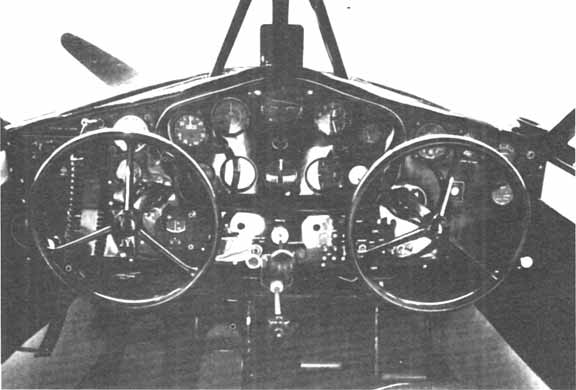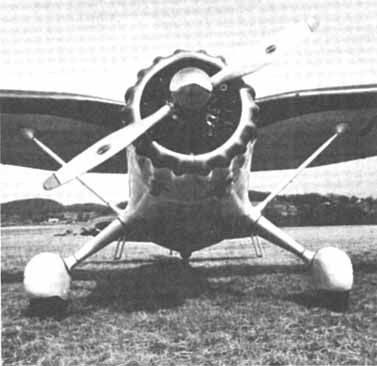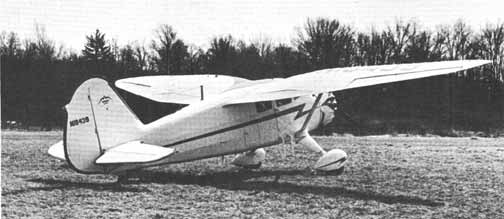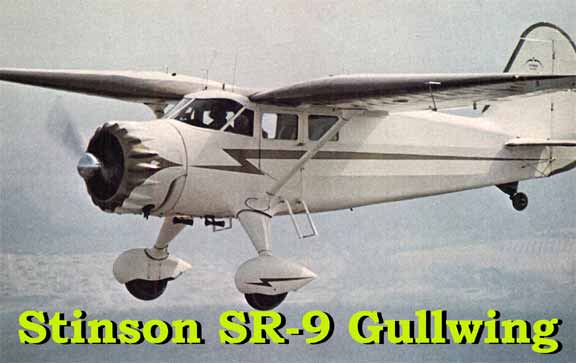|
This was written, as the saying goes, "Back in the
Day." Sport aviation was just beginning to take hold and Oshkosh
didn't exist, as the first EAA convention wouldn't be held there until
the month after this article appeared. Antique airplanes were still fairly
inexpensive and parts more available. In fact, most had yet to be restored
even for the first time, as they were still on the first fix-enough-to-keep-it-flying
go around. This must have been one of the first three or four pilot reports
I penned. It's interesting to read my own words over three decades after
the fact. I've edited nothing in this text, so you're hearing the words
of a twenty-seven-year-old writer/photographer just beginning to find
his way. Also, magazines like Air Progress were limited to four pages
of color per issue and the black and white reproduction was awful. Things
in that area have come a long way.
The Reliant was built in the days when airplane was
spelled with a capital "A." People liked to travel
first class, in style, with all the comforts of home. Nobody was
going to go anywhere if they had to suffer discomfort. When the
airplane progressed to the stage where it could offer more than
a rough ride and a case of pneumonia, big business began to view
it in a completely new light. No longer a daredevil machine, it
was now a means of travel. Affluent travelers demanded comfort even
in the air, and so, the cabin airplane started out as a summer home
with wings.
The foregoing philosophy yielded many beautiful ships: the Staggerwing
Beech, the Howard DGA-15, the Noorduyn Norseman, and the Gullwing
Stinson Reliant. Before technology brought this golden era to an
end after World War II, these planes ruled supreme as the original
miniairliners. They were capable of carrying anybody anywhere in
the manner to which they were accustomed.
These queens of the low-frequency airways have become favorites
among the more ambitious restorers. Ambitious, because recovering
a Reliant or a Staggerwing is like trying to recover a house.
| |
 |
| |
Although highly tapered wings supposedly
lead to tip stall you can't prove it by the Reliant. Its
stalls are super benign and well mannered. |
Many
of these big birds have come to roost at the annual EAA convention
in Rockford ( Ed: Now this is an OLD pilot report). That's
where I first saw Stinson SR9C, N18439. I heard somebody exclaim,
"Look at that!," and I turned to see an iceberg-sized
airplane lumber into line and take its place among the others. The
normal planes looked small in comparison; the homebuilts looked
like part of her brood waiting for dinner. That's when I felt that
old I'd-sure-like-to-flythat-one urge, not knowing that I'd eventually
get the chance.
The next time I saw N18439 she had migrated east and was the prized
possession of Fred Morris and John Yansura; they kept her at Flanders
Field, in north Jersey. She hadn't lost any of that aura of grandness;
she shone even brighter. N18439 is a 1937 SR9C, the Reliant model
that some purists consider the most desirable.
The model R Reliant was born in 1931 as a redesigned, hopped-up
version of the older Stinson Junior. Bob Ayer, of GeeBee fame, had
come on board, specifically to get speed out of the Junior. The
cantilever gear and new fuselage shape were his ideas. The original
Reliant wing was the straight barn door of the Junior, but as the
design was refined through to the SR7, the planform was changed
to a birdlike shape and the thickness was made to taper out to the
struts and then back down out toward the tips, giving it a gull
shape-the Gullwing Stinson was created.
The crash survivability of a Reliant must be fantastic, judging
from its construction. The fuselage is a maze of steel tubing; the
wing spars are also a tubing truss. A thousand years from now some
archaeologist will dig up the fossilized remains of a Reliant and
think he's come upon the skeleton of a huge prehistoric bird.
There are conflicting theories and tales about the heat treating
of the steel truss works of the Reliant and the problems involved
in repairing certain parts. According to Fred Morris, in the civilian
SR series, only the gear is heat treated, while in the military
version, the V-77, the wing spars are heat treated.
To make a 3,800-pound, 42-foot, high-wing airplane perform takes
a lot of brute force; the force ahead of 39's firewall is a Lycoming
R-680-9 with 300 hp. Nothing carries the oldtime airplane sound
quite as well as a big radial at idle, and the Reliant's big round
engine certainly has that sound.
Fred and John take great care in keeping their monster machine well-groomed;
the engine is as clean looking as it is clean sounding. Because
of the sheer mass in the engine package, and the sculptured cowl,
one's eyes automatically track straight to the engine when the airplane
is first sighted. Its blunt, chromed nose and the many-cylindered
round engine are a good introduction to the rest of the airplane.
Going back down the fuselage, and stepping around the barrel-sized
pants, we climb aboard via a short stepladder. The ladder isn't
there to make boarding easier, it's there to make boarding possible.
The bottom edge of the door is nearly waist high—it would
take a second-story man to make it up without the ladder.
The door is thick and the opening it covers is large. The interior
resembles a well-appointed sitting room. The rear seat accommodates
three normal-sized men with a minimum of squashing and a maximum
of legroom.
The impression of size heightens as you move forward and settle
down in the driver's seat, with the huge, polished, round wheel
in front of you.
The interiors of most restorations are disappointing, especially
in regard to details that go toward making a panel appear clean.
The inside of 39 is just as sharp as the outside; the panel is a
work of art. Its black enamel is spotless and every screw head,
every instrument, looks as if it has never been touched. The 1936
Ford-type panel grouping has flight and engine instruments completely
separated and mounted in recessed panels. The width and height of
the panel and the elbow room on the flight deck give one the impression
of being in an old airliner or perhaps on the bridge of a ship.
The Stinson is started with the prop in the low rpm position. The
big 300 Lyc took a bit of priming to coax to life, but it eventually
belched the oil it had collected in the lower cylinders, blew a
cloud of smoke, and settled into that low, throbbing rumble that
raises goose bumps.
Almost all taxiing and tight maneuvering on the ground is done with
brakes because the tailwheel is full swiveling with a lock for straight
ahead. Visibility is adequate, but just barely. There is a tremendous
blind spot to your right because the other side of the cockpit is
so far away that you have to S-turn tightly to see anything on your
right front quarter.
| |
 |
| |
The Reliants, like all airplanes of
their day had an art deco flair to their panels that would
be a shame to smudge with stuff like modern radios and gyros.
|
|
It seemed as if every airplane in the country
picked this day to shoot touch-and-goes, and a Reliant is definitely
not the perfect vantage point for monitoring traffic. It has too
much airplane and not enough windshield.
Once traffic decided to let us go, we lined up and I reached under
the seat and pushed the tailwheel lock down to lock the wheel in
position. Fred had told me to pick the tail up at about 65 mph,
and to lift off at about 80.
I guess I'm used to an airplane that tells me when it's ready to
lift its tail, but there was absolutely no feeling in the controls
that said the tail was light and ready to go. Fred had to tell me
when to push, and then he had to help me because I wasn't being
forceful enough. The same is true of lifting off. When 80 mph comes
around on the dial, it takes a fairly good tug to get 39 off the
deck. Fred says she'll fly herself off, but it takes a lot less
runway if you forcefully pick it up.
In a cruise climb of 100 mph, we were getting better than 1,000
fpm with full tanks and three aboard. Some airplanes let you know
that you're climbing fast because they grunt and groan and show
how hard they're working. Not the Reliant. It climbs as effortlessly
and as smoothly as a hot-air balloon. The only indication of vertical
velocity is the rapidly vanishing ground.
All size, or bulk, disappeared as soon as we left the ground. At
cruise, it handles better than many so-called sports/ trainers.
I was really surprised how it responded to aileron and elevator.
It's no fighter, but it doesn't need two hands, which the tractorsize
wheel would indicate. The roll rate and control feel is similar
to a Cessna Cardinal, which is saying a lot considering that the
Reliant weighs about twice as much.
In cruise, N18439 takes quite a nose-down attitude to maintain level
flight. This attitude helps forward visibility immeasurably, but
the cabin roof and wing roof juts far enough forward that a lot
of sky is hidden. In the 1930s, traffic problems were not what they
are today, so visibility wasn't quite as important. Most airplanes
of this era have the same problem.
| |
 |
| |
This sucker redefines the term
"big and beautiful." Its 300 hp R-680 Lycoming
appears almost small on its wonderfully sculptured nose.
The cantilever gear system uses inboard shock absorbers
a system that would show up again on the 108 series Stinsons.
|
Radials don't make much noise, and the cabin walls are so thick
that the noise level is about as low as it could be. Normal conversation
was easyone of the reasons the Reliant was so popular with the prewar
"in" crowd.
No pilot report is complete without a thorough investigation of
the stalls, even though few airplanes exhibit really hair-raising
characteristics. The Reliant is like the rest, even though it's
like full-stalling a house. The nose comes up, the airspeed goes
down, the airplane shakes, the nose drops, and forward pressure
and power remedy the situation. No sweat! Old-time bush pilots used
to be able to land Reliants in unbelievably tight corners, partially
because of its power and the absence of low-speed tricks. I later
proved that it takes a better pilot than me to park a Reliant in
a pea patch.
One thing about the Reliant that really surprised me is that with
all that wing, I expected it to float down, but its glide is more
of a trajectory than a glidepath. With zero power it bottoms out
at around -1,500 fpm, but with the power back and the vacuum-operated
flaps out, the VSI needle goes past 2,000 fpm like a shot. You wouldn't
have a whole lot of time to pick out a field when this one quits!
Keeping in mind that we were going to come to a screeching halt
when I brought the power back, I tip-toed into the pattern. I gave
myself plenty of room and moved the base leg out a bit so I could
make a power approach. Fred told me to make final a little high
and add flaps. I, naturally, overdid it.
In a normal airplane I would have floated right past the field,
but when those flaps came out and the nose pitched over, the runway
came right back up where it should have been. I held 85 mph most
of the way down final, slowing it to 80 mph over the fence. Fred
says he always wheels it on, so I thought I would, too. At least,
that's what I thought. As the speed fell and I tried to level off,
the control forces seemed to build up and were as heavy as they
had been on takeoff.
What was supposed to have been a thistledown landing turned out
to be the original Jersey bounce. I dribbled and skidded and waddled
down the runway on the mains. Fred says he puts it on main gear
first and lets the tail fall immediately, rather than trying to
hold it up. I didn't get a chance to test his technique. My arrival
was so sloppy I couldn't really tell whether or not it was easy
to land. My only conclusion is that it must be fairly forgiving,
all things considered, or I would have wrapped it up right there.
Fred said that he had no trouble transitioning and he really had
a transition. He owned a Smith Miniplane when he checked out in
the Reliant! ( Ed: I’ve since found that once used to the
airplane, it’ll squat onto the mains with little effort and
is actually fairly easy to land for its size)
At 130 mph and 15 gallons an hour, the Reliant is one of the classiest,
most luxurious ways of traveling. Each monthly issue of Trade-A-Plane
shows at least a couple Reliants for sale, averaging between $4,500
and $8,000 ( Ed: not any more!). You can move at the same
speed, carry more people, and have twice the fun of a Cherokee,
for little more than half the price. You do have to worry about
fabric and oil leaks, and a few parts are hard to find, but one
look at the early morning sun bouncing off that big cowling makes
it all worth it. Besides, you can always set up housekeeping in
it.
| |
 |
| |
From this angle it's easy to see how
the Reliant got the nickname, "Gullwing." |
| Some
Random Personal Thoughts From 2006
If you ignore the miles per gallon, something like a Stinson
Reliant still makes sense as a piece of transportation. It's
considerably faster than a 172 (the honest ones, not those
in the advertisements), carries everything you own and raises
"class" to a higher artform. Obviously, it's not
a fly-and-forget airplane like a 172 and you're always tinkering
it. Plus, it demands you know how to fly, not drive. All of
this, of course, is not worth even considering as obstacles
when the class and overhwelming presence of the airplane is
considered. Besides, when was the last time you taxied up
to a gas pump in a 172 and had people crowding around it or
stretched out in the back seat to snooze? |
|
|

